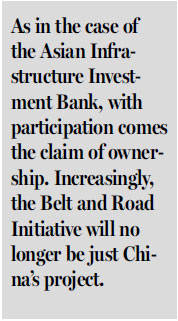Initiative a project for all stakeholders
Since its launch in 2013, the Belt and Road Initiative has been subjected to two divergent discourses on its characteristics and aims. The discourse emanating from China - the internal discourse - presents the Belt and Road Initiative, at its most modest. It presents it as a trans-national infrastructure project to build interconnectivity (greater trade, infrastructure and people-to-people links) among Eurasian countries and promote the economic development and prosperity of Asian, African and European economies along the Belt and Road.
More recently, the initiative has been presented as an embodiment of the grand Chinese vision of, as well as a series of policy initiatives in, constructing a community of shared future for humankind and in promoting mutual learning and development among civilizations.

The discourse outside China - the external discourse - offers a sharply different representation and interpretation of the initiative's principal purposes and strategic intentions. It sometimes sees the initiative as "China's Marshall Plan", an economic project with strategic significance for "dictating terms" to the world. The initiative at times is also regarded as the 21st century Chinese attempt to reconstruct a Sino-centric economic order, a reincarnation of the traditional Chinese tributary system that entrenches China's economic dominance.















